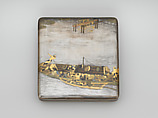Writing box (suzuribako) with passenger boat on the Yodo River
Follower of Shiomi Masanari 塩見政誠 Japanese
Not on view
The exterior of this large-size writing box (suzuribako) is embellished with a scene inspired by Utagawa Hiroshige’s print, On the Yodo River, which was published in 1834 as part of the Famous views of Kyoto series. The Yodo is the sole outlet of Lake Biwa, connecting the Kyoto area with Osaka. The river was a major means of transportation during the Edo period, and the writing box shows a large passenger boat heading from Fushimi to Osaka. The passengers are buying food and sake from a small peddler boat that has pulled alongside the larger vessel. In the background and on the interior of the box, the famous waterwheel of Yodo Castle and its surroundings are depicted, perhaps inspired by another well-known print by Katsushika Hokusai, Moonlight on the Yodo River (1833). On the interior of the lid, against the Yodo Castle’s birds-eye view, a bridge is depicted with passers-by. These rare, ukiyo-e based designs are executed in the style of Shiomi Masanari (ca. 1646–1719) a lacquer artist who was well-known of his high-quality togidashi (burnished down) maki-e compositions. He had several students and followers who emulated his style on inros and smaller lacquer items. Writing boxes with silver ground are particularly distinctive. Here, the artist has used this metal to express the shimmering waves of the river.
Due to rights restrictions, this image cannot be enlarged, viewed at full screen, or downloaded.

